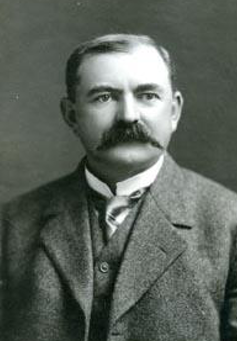
1862 -1932
Born in Cobourg, Ontario, John Weller enrolled at RMC in February 1880, with 33 others, graduating fourth overall in 1883, and receiving a First-Class Certificate in Engineering.
Excelling in sports at College and later during his army career, Weller won many honours. He won the obstacle race and was College rifle champion in 2nd year. Later with the Dominion Rifle Association, he won the Thorburn Prize and Sir Donald Smith Cup and was on the Bisley Rifle Shooting Prize Lists and Canada's Kolapore Team to Britain. He was the first winner of the Admiralty Trophy with the American Canoe Association in 1884, and at age 58, runner up to an Olympic gold medalist for the Canadian Senior Golf Championship in 1920.
Weller's military career spanned four and a half decades. As a young engineer, he was first assigned to survey for locks on the Trent Valley River system (1883), and the Murray Canal, near Brighton (1884), which launched his lifetime career in canal engineering. With the 57th (Midland) Battalion during the Northwest Rebellion in 1885, he served as Staff Adjutant to Major General J.W. Laurie.
He was promoted to Assistant Engineer for the Cornwall Canal enlargement in 1887 and became Resident Engineer in 1892. He joined the 59th Stormont and Glengarry Battalion of Infantry in Cornwall and was promoted Major in 1897. In 1900 he was assigned to the Port Colborne Harbour Improvement, and later that year to Superintending Engineer of the Third Welland Canal.
His greatest achievement was his role as Engineer-in-Charge of the planning, surveying and construction of the 4th Welland Ship Canal between Lake Ontario and Lake Erie from 1912 to 1932. To circumvent the natural wonder of Niagara Falls, a man-made wonder was required. The Welland Canal continues to act as the western section of the St. Lawrence Seaway (opened in 1959), the deep waterway that allows large Great Lakes cargo ships and ocean vessels to navigate between the heart of North America and the Atlantic Ocean. The canal ranks as one of the outstanding world engineering feats of the twentieth century.
Beginning in 1824, earlier canal routes wound their way across the Peninsula and up the Niagara Escarpment following natural water routes because technology was not available to survey and build a straight alignment for the 99.5 m (326.5 ft) elevation difference. Under Weller's leadership, an entirely new concept in canal building was shown to the rest of the world. At the time, the 4th Welland Ship Canal was the largest individual engineering works carried out in Canada and one of the largest in the world. Although patterned after the Panama Canal, the lift achieved is higher over a much shorter distance.
Weller cut a straight path over the Escarpment, creating a more efficient and direct route. Weller incorporated reinforced concrete in his design, a concept he had employed earlier in building the world's tallest reinforced concrete poles to carry electric transmission lines over the 2nd Welland canal.
Weller initiated the use of massive machinery to support and operate his massive construction. Where the 3rd Welland canal had incorporated 26 stone locks, Weller reduced the Welland Ship Canal to 8 immense locks to accommodate large modern shipping in a 2-way system. The control lock at Lake Erie was the longest in the world at 1148 feet. The canal is 43.4 km (27 mi) long and its locks, which provide an average lift of 14.2 m (46.5 ft), are 233.5 m (766 ft) long and 24.4 m (80 ft) wide.
Port Weller, Ontario, was named in John Weller's honour. Two Weller Islands may be found in Georgian Bay. The Concrete Pole Company was founded in 1905 by Weller and W.H. Sullivan. Concrete Pipe and Products Limited was founded by Weller for the manufacture of concrete pipe, concrete block, and other concrete products. He served on the Council of the Canadian Society of Civil Engineers (CSCE) from 1915-1917. In 1932, the year the Welland Ship Canal opened and the year he died, Weller was named a Life Member of the Engineering Institute of Canada.
John's only son, 748 William Henry Weller, graduated from RMC in 1909 and joined the Royal Flying Corps.
Plaque inscription:
Athlete, canal builder, Welland Ship Canal engineer-in-charge